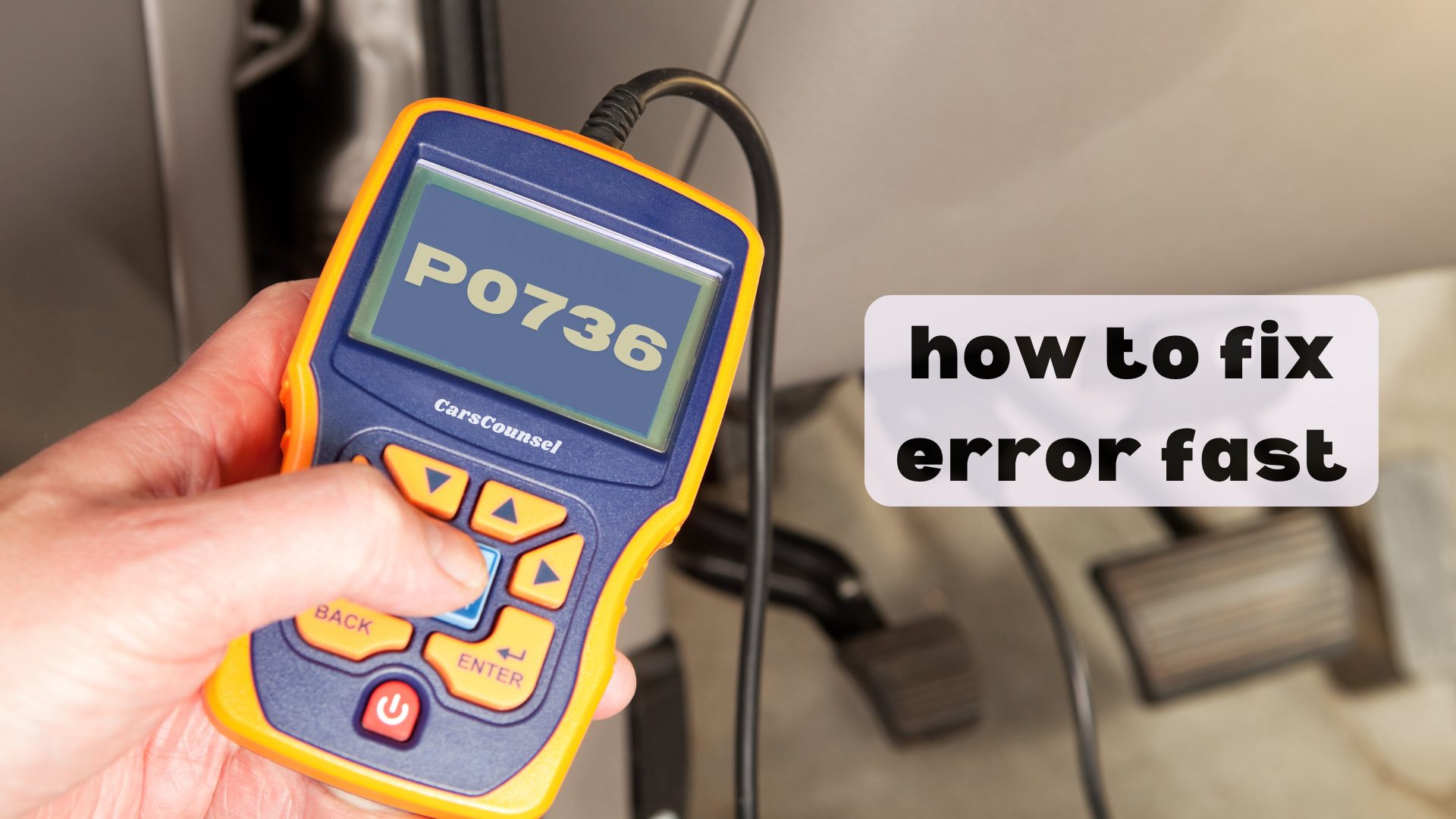When your car shows a P0736 code, it usually means there’s a OBD2 problem with the reverse gear ratio.
To fix this quickly, start by checking the transmission fluid levels and quality; low or dirty fluid can mess up gear engagement.
If the fluid looks good, then check the solenoids and sensors, as these parts are important for the transmission to work right.
Want to know how to spot bad solenoids or avoid future problems? Let’s go over the next steps you should take.

Quick Navigation
Key Takeaways
- Check and top off the transmission fluid if it’s low.
- Look at the solenoids and sensors, and replace any that are bad.
- Check the wiring for any damage and fix or replace it if needed.
- Run diagnostic scans to find the exact problems.
What Is the P0736 Code?
The P0736 code means there’s a problem with the reverse gear in your car’s transmission. This code shows up when the transmission control module (TCM) notices that the gear ratios aren’t matching up as expected when you put the car in reverse.
This issue can be caused by things like low transmission fluid, bad sensors, or internal damage. It’s important to fix this issue quickly to avoid more damage and to keep your car running smoothly.
Regular maintenance, such as checking fluid levels and inspecting transmission parts, can help prevent these problems. Ignoring the P0736 code can lead to serious transmission issues, higher repair costs, and safety risks.
Getting it diagnosed and repaired promptly is key to keeping your car in good shape.
Symptoms of P0736 Code
Having trouble shifting into reverse often means you have a P0736 code. You’ll find that the transmission isn’t working well, making it tough to smoothly get into reverse gear.
This problem can also make it harder to shift into other gears, affecting how your car drives overall. You might see the check engine light come on, signaling a bigger issue with the transmission.
Your car might also use more fuel because the transmission isn’t running efficiently. It’s important to take care of these issues quickly to avoid bigger and more expensive problems later.
Catching these signs early can save you a lot of hassle and money.
Risks of Ignoring P0736
Ignoring the P0736 code can lead to serious transmission damage, higher repair costs, and safety risks while driving. If you don’t address this issue, you risk damaging your transmission, which could eventually fail completely.
Safety concerns arise because your car might suddenly lose its ability to go in reverse, putting you in dangerous situations. Long-term effects include not only higher repair costs but also less reliable performance from your vehicle.
Ignoring this code can also put extra stress on other transmission parts, making the whole system less efficient and causing more problems.
Fixing the P0736 code right away ensures your vehicle stays safe, reliable, and cheaper to maintain in the long run. Don’t let a small issue become a big problem.
Common Causes of P0736
To fix the P0736 code, you need to know its common causes. These include low transmission fluid levels, bad solenoids and sensors, damaged wiring, internal transmission damage, and problems with the transmission control module (TCM).
Low transmission fluid can make it hard for the gears to engage properly, which might cause slipping or make it impossible to shift into reverse.
Bad solenoids and sensors can send wrong data to your car’s computer, causing transmission issues.
Damaged wiring or connectors can mess up signal transmission, which disrupts normal operation.
Internal transmission damage, often from wear and tear or poor maintenance, can also trigger the P0736 code.
Lastly, a faulty TCM can mismanage gear engagement, making the problem worse.
Knowing these causes is key for diagnosing and fixing the issue.
Low Transmission Fluid
Low transmission fluid can cause serious problems with your car’s gears, like slipping or having trouble shifting into reverse.
Keeping up with transmission maintenance and using good-quality fluid is crucial for your car’s performance.
Here’s how to handle low transmission fluid:
- Check fluid levels: Regularly look at the transmission dipstick to make sure the fluid level is correct.
- Check fluid quality: See if the fluid is dirty or smells burnt; if it does, you might need to change it.
- Add or replace fluid: Use the transmission fluid recommended by the manufacturer to keep everything running smoothly.
Keeping your transmission fluid at the right level and in good condition helps avoid problems and makes your transmission last longer.
Faulty Solenoids and Sensors
Bad solenoids and sensors can mess up the data your car’s computer uses, causing gear problems like the P0736 code.
To fix this, start by testing the solenoids to make sure they’re working properly. If a solenoid is faulty, replace it right away.
Also, sensors that send wrong information can add to the issue. Do a full check to find any bad sensors and replace them if needed.
Making sure both solenoids and sensors are working well helps keep your transmission system in good shape and prevents future problems.
Diagnosing P0736
After making sure that the solenoids and sensors are working correctly, the next step is to accurately diagnose the P0736 code. Start by using diagnostic tools to scan your vehicle’s computer for error codes. This will help you figure out potential problems and give you a starting point for further checks.
Use these troubleshooting steps to find the issue:
- Check Transmission Sensors: Use diagnostic tools to make sure the sensor signals are accurate.
- Look at the Wiring: Check for any visible damage or corrosion that could affect signal transmission.
- Run System Tests: Perform road tests, stall tests, or pressure tests to evaluate the overall health of the transmission system.
These steps will help you find the root cause of the P0736 code and guide you to the right repair.
Checking Transmission Fluid
To check the transmission fluid, make sure your car is on a flat surface and the engine is warm.
Find the transmission dipstick, which is usually labeled and near the engine.
Pull out the dipstick, wipe it clean, put it back in fully, then pull it out again to check the fluid level. The fluid should be between the ‘Full’ and ‘Add’ marks.
Also, look at the fluid’s color and smell—it should be clear red and have no odor. If it’s dark or smells burnt, you need to change the fluid.
Checking the fluid regularly helps keep your transmission in good shape and can prevent problems.
Repairing Transmission Issues
Start by checking and changing the transmission fluid if it’s low or dirty. This is usually the easiest and most effective first step in fixing transmission problems. Regularly maintain your transmission to ensure the fluid is at the right level and clean.
Here’s what you can do:
- Change the Fluid: Drain the old fluid and fill it up with the type recommended by the manufacturer.
- Check Solenoids and Sensors: Look at the transmission solenoids and sensors, and replace any that aren’t working right.
- Fix Wiring and Connectors: Repair any damaged wires or connectors that could mess up the signals.
Preventing P0736 Recurrence
To stop the P0736 code from coming back, you need to do regular maintenance and check-ups. Start by making sure you stick to a routine for preventing problems.
Regularly check your transmission fluid levels to keep your gears working smoothly. Look at the transmission sensors and solenoids to make sure they’re working right, and check the wiring and connectors for any wear or damage.
Fix any small issues right away so they don’t turn into big problems later. Also, think about getting your car checked by a professional now and then to catch any early signs of trouble.
This won’t just help prevent the P0736 code but will also make your transmission last longer. By being careful and proactive, you can keep your transmission in good shape and lower the chances of this error happening again.
More OBD-II Codes
Frequently Asked Questions
Can Driving Habits Affect the Likelihood of Triggering a P0736 Code?
Yes, the way you drive can affect the chances of getting a P0736 code. Driving aggressively can wear out the transmission faster, making problems with the reverse gear ratio more likely. Driving smoothly and carefully can help keep your transmission in good shape and prevent issues.
What Tools Are Needed for Diagnosing a P0736 Code at Home?
To get started, you’ll need a code reader to check error codes, a dipstick to check the transmission fluid, and some basic tools to look at the wiring and connectors. This will help you diagnose the problem accurately and fix it quickly.
Are There Specific Driving Conditions That Exacerbate P0736 Code Symptoms?
Driving on hilly roads or in bad weather can make the symptoms of a P0736 code worse. You’ll have more trouble shifting into reverse and your fuel efficiency will go down. It’s important to fix this issue quickly to keep your car running well and safely.
How Long Does It Typically Take to Fix a P0736 Code?
It usually takes about 2-4 hours to fix a P0736 code. The time it takes depends on how complicated the problem is. Costs can range from around $100 for simple fluid changes to as much as $1,500 for major transmission repairs.
Can Aftermarket Parts Contribute to P0736 Code Issues?
Using aftermarket parts can sometimes lead to P0736 code issues. If the parts are of poor quality or not compatible with your transmission, they can cause problems. Make sure any aftermarket parts you use meet the required standards for your transmission. Always check the quality of aftermarket parts before installing them to ensure proper performance and to avoid issues.
Conclusion
Imagine driving down the highway without worrying about the check engine light coming on.
By quickly dealing with the P0736 code through simple steps like checking the fluid, inspecting the solenoid, and looking at the wiring, you ensure your transmission runs smoothly.
Regular maintenance keeps your car reliable and extends its life.
Don’t let this annoying code ruin your drive—act fast and enjoy the confidence of a well-maintained transmission.

